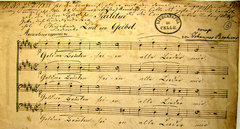Two previously unknown works by Johannes Brahms discovered
Helmut Lauterwasser
Wednesday, June 23, 2010

The copies of the two male voice choral pieces on texts by Emanuel Geibel and Wilhelm Müller are among the estate of the Alten Celler Liedertafel (Old Celle Vocal Society). Johannes Brahms, then only 19 and completely unknown, performed in Celle in May 1853 together with the Hungarian violin virtuoso Eduard Reményi and presented the two songs to the men’s choir of the town as thanks for their support during his time performing there. He presumably composed the first song, Goldne Brücken seien alle Lieder mir (text by Geibel), in 1853 expressly for the Liedertafel. The second song, however, must have originated a few years earlier, between 1847 and 1852 – which olny makes Brahms between 14 and 18 years old at the time – in Winsen/Luhe, where Brahms spent holidays of several months, during which he also conducted the local men’s choir. His correspondence with the daughter of his host in Winsen, Elise Giesmann (later Denninghoff), reveals that he demanded she return manuscripts of pieces for men’s choir he had written for the Liedertafel in Winsen, which he then destroyed. There is reliable evidence that Postillons Morgenlied, whose text begins “Vivat und ins Horn ich stoße” (words by Müller), was also among them.
Both works were first published by Breitkopf & Härtel, Wiesbaden (Choral Library 5321, edited by Helmut Lauterwasser). About 157 years after their composition, the songs were heard again, sung by the Bavarian Radio Choir, in the course of its annual press conference on 5 March 2010. This was an important event both for Brahms scholarship and the musical world in general because it meant the performance of the very earliest surviving music of Brahms.
Click here to hear thechoral pieces online.
Share Tweet EmailCatégorie: Redécourvertes

